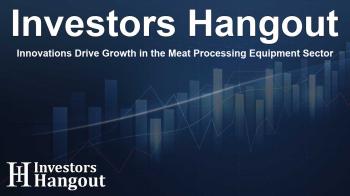Innovations Drive Growth in the Meat Processing Equipment Sector

Insights into the Expanding Meat Processing Equipment Market
The global meat processing equipment market is anticipated to experience significant growth, projected to reach USD 16.36 billion by 2032. This remarkable increase from its value of USD 11.25 billion in 2024 represents a robust compounded annual growth rate (CAGR) of 4.86% from 2025 to 2032. The factors driving this expansion include a major shift towards automated, hygienic, and sustainable meat production solutions.
Rising Demand for Automation and Sustainability
As meat processors prioritize modernization, there's a growing emphasis on automation and operational efficiency. The push toward food safety and sustainability is propelling investments in advanced equipment, including state-of-the-art slicing, grinding, and packaging technologies. These innovations not only improve productivity and reduce labor costs but also ensure compliance with strict hygiene regulations.
Consumer Preferences Influencing Equipment Choices
Today's consumers are increasingly favoring clean-label and traceable meat products, which ironically influences the types of machinery that manufacturers invest in. It becomes crucial for processors to utilize equipment that can consistently deliver high-quality, low-contamination products to meet these expectations.
Market Dynamics in the U.S. Meat Processing Sector
The U.S. meat processing equipment sector alone is projected to grow from USD 1.71 billion in 2024 to USD 2.70 billion by 2032, at an impressive CAGR of 5.96%. This growth mirrors the broader trends seen globally, with an emphasis on innovative solutions that enhance meat product safety and quality.
Understanding the Key Players of the Market
Several industry players dominate the market landscape, including Mepaco, Minerva Omega Group s.r.l., and Tomra Systems ASA, among others. These companies are at the forefront of technological advancements, driving significant improvements in meat processing capabilities.
The Role of Slicing Technology
The slicing segment is expected to capture the largest market share, projected at around 24% in 2024. Consumers’ preference for visually appealing, portioned, and packaged meat products fuels demand for slicing machines that ensure uniform thickness and packing efficiency. Integrating advanced technologies like programmable logic controllers (PLC) enhances the precision of these units, thereby mitigating operator errors and accelerating production.
Beef Processing Trends Taking the Lead
Beef continues to be the most processed meat, occupying the largest market share of approximately 40% in 2024. The complexity involved in beef processing operations necessitates high-performance, sanitary equipment while complying with stringent food safety regulations. Additionally, advancing preparations for value-added beef products like marinated cuts heighten the need for specialized machinery that guarantees quality throughout the production process.
Regional Insights: Asia Pacific vs. North America
In 2024, the Asia-Pacific region dominated the market with around 34.25% of the revenue share, focusing heavily on large-scale production and reduced processing durations. Investments in modern processing infrastructures enhance the efficiency to accommodate rising meat consumption rates, particularly in urban centers.
Conversely, North America is set to witness a notable CAGR of approximately 6.19%. With a surge in automation, processors are adopting robotic and AI-driven equipment, aiming to improve yield and consistency while ensuring hygiene standards.
Conclusion: A Bright Future for Meat Processing Equipment
The future for the meat processing equipment market appears bright, as automation, sustainability, and innovation continue to pave the way for growth. Enhanced consumer expectations and regulatory demands drive companies to invest in cutting-edge technologies. This convergence of trends promises a transformative era for the meat processing sector, fostering advancements that meet the intricate needs of both producers and consumers alike.
Frequently Asked Questions
What is the projected market value of meat processing equipment by 2032?
The meat processing equipment market is expected to reach USD 16.36 billion by 2032.
What is driving the growth of the meat processing equipment market?
Key drivers include automation within production facilities, consumer demands for quality and traceability, and the push for sustainable practices.
Which segment is expected to lead the market?
The slicing segment is projected to capture approximately 24% of the market share in 2024 due to its pivotal role in producing portioned meat products.
What percentage of the market does beef processing hold?
Beef processing accounted for about 40% of the market share in 2024, driven by its complex processing requirements.
Which regions are leading in the meat processing equipment market?
Asia Pacific holds the largest revenue share, while North America is also poised for substantial growth through automation and safety innovations.
About The Author
Contact Thomas Cooper privately here. Or send an email with ATTN: Thomas Cooper as the subject to contact@investorshangout.com.
About Investors Hangout
Investors Hangout is a leading online stock forum for financial discussion and learning, offering a wide range of free tools and resources. It draws in traders of all levels, who exchange market knowledge, investigate trading tactics, and keep an eye on industry developments in real time. Featuring financial articles, stock message boards, quotes, charts, company profiles, and live news updates. Through cooperative learning and a wealth of informational resources, it helps users from novices creating their first portfolios to experts honing their techniques. Join Investors Hangout today: https://investorshangout.com/
The content of this article is based on factual, publicly available information and does not represent legal, financial, or investment advice. Investors Hangout does not offer financial advice, and the author is not a licensed financial advisor. Consult a qualified advisor before making any financial or investment decisions based on this article. This article should not be considered advice to purchase, sell, or hold any securities or other investments. If any of the material provided here is inaccurate, please contact us for corrections.

